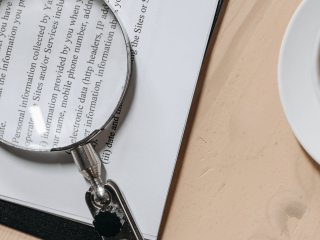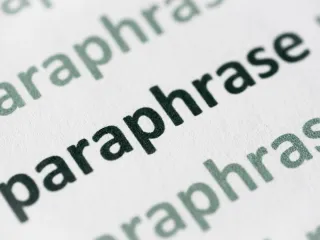When you’re writing a research paper, you’ll use a variety of sources to find information. You might find that you end up using other people’s research papers as sources of information for your own work. You need to know how to cite a research paper properly.
Using text citations tells readers where you got your information, and help build a sense of trust, allowing the reader to feel confident that you haven’t falsified the information. You have to prove that you’ve done the research and found data to back up the claims you’re making.
Writing a paper without giving credit to people whose work you’re using is plagiarism. Unless you’re citing a direct quote you want to change the language enough, by putting the quote in your own words, so it sounds like original content. Quetext’s plagiarism checker helps you search for similar content across the web so you can turn in a completely original paper.
Whether you’re submitting a research paper to school or for publication in a peer-reviewed journal, you’re required to cite your sources. Editors often reread the work of writers and researchers to ensure the information is factual. A teacher or professor will definitely check that your sources are accurate, so using tools like Quetext will help avoid unintentional plagiarism errors or wrongfully cited information.
Why Text Citations are Important
If you don’t have sources to back up your research, others might accuse you of spreading false information or plagiarism. Any journal publishing papers should verify what they’re printing, but ultimately, as the author, the buck stops with you.
In general, it’s a kindness to cite your sources. The people who created them did a lot of work, so it’s wrong to claim ownership of their ideas and information. But it’s also an ethical issue that can have major repercussions.
There have been cases where researchers make up information or falsify their sources and must face the consequences. People depend on factual information and don’t react well when they realize you lied to them or falsely paraphrase information.
That’s why it’s common knowledge to write a well-researched paper with text citations. If anyone claims your information is incorrect, you can point them to the source where you found the data. This doesn’t guarantee that the information you cited is correct, but you’ll be able to provide readers with a source of where you gathered your information.
When you’re citing other people’s research papers, make sure the source is legitimate. You should only use peer-reviewed journals so you know the article has gone through edits and fact-checking. Something identified as a research paper that is only on a blog or message board isn’t always a reliable source.
Many students like to use Wikipedia because there’s so much information available from one source. However, Wikipedia allows users to edit the information. What you read in a specific entry might not be true. It’s best to scroll down to the works cited and go to the original source yourself. If you can’t find a reliable, original source for the information, you shouldn’t use it.
Using the Various Citation Styles
The information used in any citation is basically the same across each style guide. The formatting and order of some elements may vary, so it’s important to know the difference between Modern Language Association (MLA), American Psychological Association (APA), and Chicago Styles.
The style you use depends on what type of writing you’re doing. All will use these basic elements in some form or another:
-
Author(s)
-
Editor(s)
-
Title(s)
-
Source name
-
Volume and edition
-
Publication date
-
Page numbers
-
Publisher name
-
City and country of the publisher
-
URL and DOI for web pages and digital sources
-
The date you accessed the material
In addition to a reference list at the end of your work, you’ll also use in-text citations. Whenever you reference an idea or data that isn’t yours, you cite it. Each style has different types of in-text citations as well. Read on to find out about each citation format.
MLA Style
You’ll likely use the MLA citation guide if you’re writing papers in the humanities, such as for language arts, literary criticism, cultural studies, and more. The current edition of the MLA Handbook is the ninth because the style constantly evolves. As new technology creates new potential sources, MLA adds information to help students and researchers cite everything correctly.
The MLA Handbook has instructions on how to cite song lyrics, social media posts, and digital images, along with all of the standard research outlets. The book also gives detailed information on how to cite a research paper.
The MLA Handbook includes information about how to format your reference page. Use a 12-pt standard font like Times New Roman, so the text in italics is clearly different from the regular font. Center the title, Works Cited, at the top of the page. Your last name and page number are in the top right corner, and the reference page always comes at the end of your document.
Alphabetize citations according to the last name of the author. Left-align the citations and double-space them with no extra lines between each entry. When a citation goes beyond a single line, use a hanging indent to format it correctly. This lets the reader know it’s still the same citation continuing on.
Now that you know the basic format for the Works Cited page read on to find out how to cite a research paper for inclusion on this list.
Citing a Research Paper in MLA Style
When you’re citing a research paper in MLA style, you start with the author’s full name, putting the last name of the author first, followed by the title of the research paper in quotation marks. Next comes the the title of the journal that published the paper in italics, followed by the volume number, issue number, and date of publication.
You’ll also include the page number since the paper is in a journal with many pages. If you found the source online, include the digital object identifier or DOI. The DOI is a way to give a document a permanent web address so people reading your work can easily find the source.
MLA format also asks you to include the date you accessed online materials. Doing so gives your reader more information about when you read the research if it changed since that date. Here is an example of a research paper citation in MLA style:
Writer, Maria. “My Research Paper.” Research Journal, vol 3, no. 4, 2020, pp. 7-9. doi:12.34/mfs.12.34. Accessed 13 March 2021.
If the work wasn’t published online, you could stop your citation after the page numbers.
Sometimes you might find research papers that aren’t published in a scholarly journal. You can still use those in your work, but the MLA citation will look different. You’ll still put the last name of the author first, but instead of putting the title of the research paper in quotation marks, you’ll put it in italics.
Here is an example of an unpublished research paper citation in MLA style:
Writer, Maria. My Research Paper. 2020, http://websiteused.com. Accessed 13 March 2021.
These two examples show you how to document the source on your Works Cited page. In-text citations look different.
In-Text Citations for a Research Paper in MLA Style
When you’re working with the MLA format, an in-text reference requires a parenthetical citation.
If you refer to someone else’s research in a sentence, either with a direct quote or by paraphrasing, you need to give that author credit. At the end of the sentence where you use the information, you’ll put the author’s information in parenthesis and then put the sentence’s ending punctuation.
You use the author’s last name and the page number where you found the information for in-text citations. Then anyone reading your work can go to your Works Cited page, find the entry by the author’s last name, and access the document themselves. The page number directs them to where you got the specific information, so they don’t have to read the whole paper to find it. Here is an example of an in-text citation in MLA style:
Over 80% of the city’s garbage ended up in the ocean (Writer, 8).
You might mention the author’s name in your sentence. In that case, the parenthetical citation only needs to have the page numbers for reference. Here is an example:
According to Maria Writer, over 80% of the city’s garbage went into the ocean (8).
APA Style
Researchers in the social science field, like sociology, anthropology, and psychology, use the APA style in their work. Like the MLA Handbook, the Publication Manual of the American Psychological Association has gone through changes over the years. It’s currently on the 7th edition.
In addition to helping you understand how to cite research, the Publication Manual of the American Psychological Association has information about how to format your paper to include tables, figures, and headings that often accompany scientific journal articles.
The Publication Manual of the American Psychological Association also tells you how to format your reference page. In MLA style, this is the Works Cited page. For APA style, it’s either the Reference List or Reference Page.
This page uses the same font style as the rest of the paper but starts on its own page with a number in the top right corner. The title of the page is bold and centered at the top and should simply read “References.”
List citations in alphabetical order by author’s last name regardless of the type of source. Each citation is double-spaced and has a hanging indent if it goes beyond one line.
Now that you understand how to properly format your APA reference page, learn how to cite a research paper to include on the list.
Citing a Research Paper in APA Style
When you use a research paper in your work, you need to include it on your APA references page at the end of your document.
An APA citation includes the same information as the MLA format but in a different order. The citation starts with the author’s last name but only uses their first initial. Then comes the year of publication in parenthesis.
The paper’s title follows, then the title of the journal in italics. You also include the journal volume, issue number, and page numbers. As with MLA citations, include a DOI if you found the research paper online. Here is an example of a published research paper cited in APA format:
Writer, M. (2020). My Research Paper. Research Journal, 3(4), 7-9. doi:12.34/mfs.12.34
If the paper isn’t published in a journal, you can still use it in your work with a proper citation. Here is an example:
Writer, M. (2020). My Research Paper [PDF]. Retrieved from http://websiteused.com
In-Text Citations for a Research Paper in APA Style
In-text citations in the APA format differ from MLA style. You still put it in parenthesis, but you include different information. For APA parentheticals, include the author’s last name and the paper’s year of publication. This method applies when you’re summarizing or paraphrasing the author’s idea. Here is an example of an in-text citation for a research paper in APA style:
Over 80% of the city’s garbage went into the ocean (Writer, 2020).
If you’re using a direct quote from the work you need to include the page number so the reader can find the quotation. Here is an example:
Maria Writer said, “Over 80% of the city’s garbage is going into the ocean” (2020, p. 8).
Chicago Style
Chicago Style got its name from the University of Chicago, where the style originated. Writers use this format for works in the field of history, but you can also use it for the sciences, social sciences, and humanities.
MLA style has a Works Cited page, APA has References, and Chicago Style differs because it includes a Bibliography. The page comes at the end of your work with a page number in the top right corner. The title, “Bibliography,” is bold and centered at the top.
You will single-space your citations, but you’ll add an extra line between each entry. As with the other reference pages, you’ll left-align the work and use a hanging indent when a citation continues onto a second line.
Having an overview of how to format the bibliography will help you understand the citation styles for a research paper.
Citing a Research Paper in Chicago Style
Citations in Chicago Style are a mix of MLA and APA formats. It’s easiest to follow this template:
Writer, Maria. 2020. “My Research Paper.” Research Journal 3 (4): 7-9. doi:12.34/mfs.12.34.
As with other styles, you can reference an unpublished research paper as a document. Here is an example:
Writer, Maria. 2020. My Research Paper. PDF. http://websiteused.com.
In both instances, if there are multiple authors for a paper, list the rest of the authors in normal format. For example:
Author, Alan, Stanley Sample, and Maria Writer. 2020. “My Research Paper.” Research Journal 3 (4): 7-9. doi:12.34/mfs.12.34.
In-Text Citations for a Research Paper in Chicago Style
An in-text citation in Chicago Style is much simpler than both MLA and APA formats. You only need to include the last name of the author and year of publication in parenthesis with no comma in between them. For example:
Almost 80% of the city’s garbage goes into the ocean (Writer 2020).
You’ll include the page number for specificity if you’re quoting the author. Here’s an example:
Maria Writer said, “Over 80% of the city’s garbage is going into the ocean” (2020, 8).
You can also use endnotes in Chicago Style. A citation refers the reader to your source, but an endnote includes a bit of an explanation of why you used it. The information included in an endnote would disrupt the flow of your paper, but it’s still something you want the reader to know.
Make Text Citations Easy
Knowing when you need to cite a source helps you manage your research. Anytime you find information that you’re going to paraphrase, summarize, or quote in your work, you need to cite the source. The full citation will go on your reference page, but you’ll need an in-text citation where you use the information in your paper.
When you’re stating something that is common knowledge, there’s no need to make a citation. Common knowledge is something that your reader would believe without needing proof. You can check if something is common knowledge by searching for it and finding it mentioned, without a citation, in at least five sources.
Once you learn the basics about citing a research paper in MLA, APA, and Chicago Styles, you’ll feel more confident in your work. The important thing is to pay attention to small details, like capitalization, italics and the use of abbreviations. But there’s no need to do it all on your own—Quetext has a citation assistant waiting to help. Give Quetext citation generator a try on your next project.









